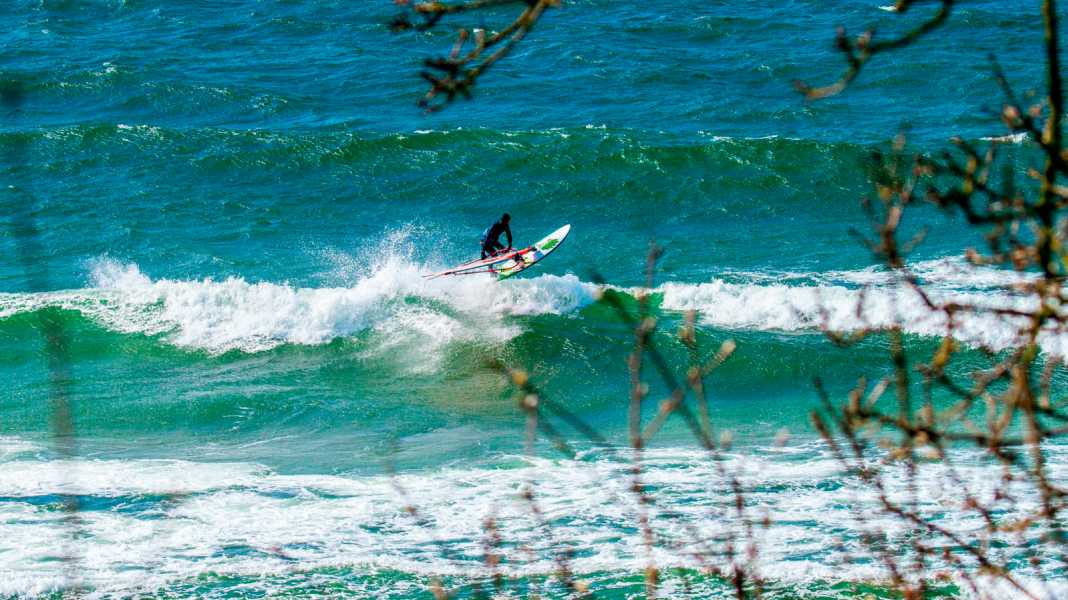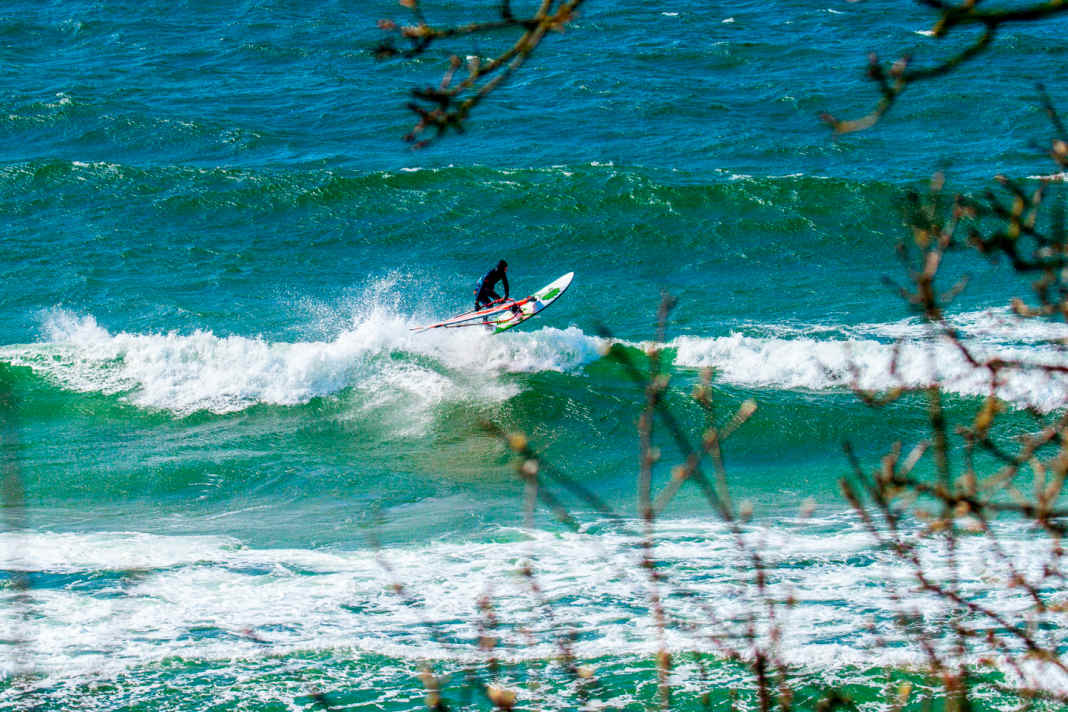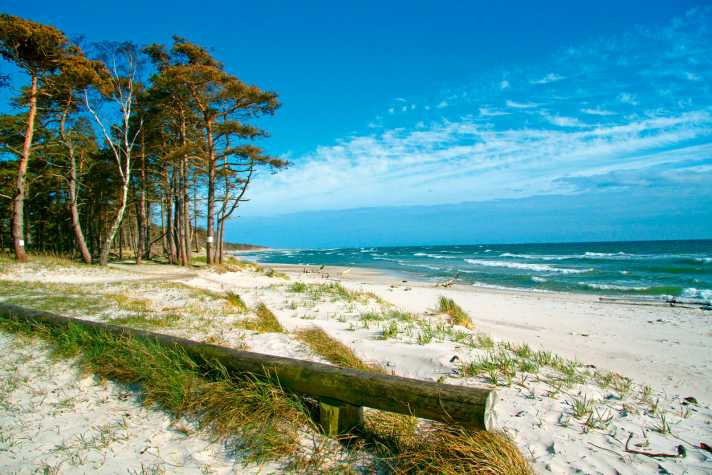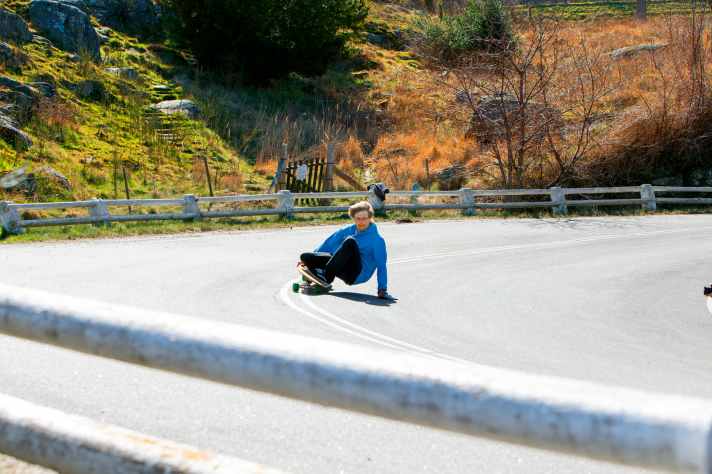
The fire in the fireplace lights up the occasional face, the record player plays rock'n'roll songs from long ago, only the rattling of the barn doors can be heard from time to time. The hoped-for warmth is gradually creeping back into our bones after a long day of surfing. Dennie comes in and wants to know how it's been today, he couldn't get out himself. Tired faces slowly look up and answer his question with a broad grin.
Dennie Hilding was probably one of the first surfers on Bornholm, he came, surfed and stayed. Three years ago, he moved from Sweden to Bornholm permanently with his wife and child. He found a farm to stay in and, as he could hardly believe that there were no surfers on the island despite the perfect conditions, he founded the "Bornholm Surf Farm". The farm was remodelled so that there is now a living room with four beds, which is heated by a fireplace. In summer, you can camp on the grounds or sleep directly under the barn roof with a sea view. There is no television, internet or modern showers - instead there is a bucket that can be filled with hot water. Only the record player, a longboard and a pool table give an idea of the leisure activities on the farm on days without waves or wind. On our first tour, we were honestly a little overwhelmed as to how we were supposed to survive here for the next two and a half weeks - if there was no wind or waves. Dennie told us that this was part of his concept. In today's society, we have too much of everything, except "time". We should focus on the essential things in life during our stay, hence the primitive shower and the avoidance of modern media. Sounds obvious, but it's difficult when you're told "time is money" every day. I could hardly imagine that this method would overturn my usual self-concept within a few days, but I was proved wrong.






Analogue days
The first morning started early as usual. "Where do we want to look for spots first? What's the forecast for the next few days?" Typical surfer problems. We bloody well need internet. So we quickly book the EU data package and check the forecast, then quickly scroll through Google Maps again to virtually "discover" potential spots. Now just a quick check of the mails, something important might have come in. The internet stops loading, my mobile phone vibrates and a text message appears: "Your data volume has been used up." That's it, we'll never find the right spot! How did the surfers before us do it without the internet? I put my mobile phone aside and let my gaze wander around the room. Hanging on the wall is an old nautical chart of Bornholm that I hadn't even noticed before. From now on, it will serve as our navigator.
We decide to explore the south as, looking out of the window, no spot seemed to work from our current northern position. The contrast between the north and south of the island is much greater than you would expect at 45 kilometres. The north is mountainous, with gradients of up to 15 per cent, large rocks, waterfalls and deciduous trees. The south, on the other hand, is rather flat, full of coniferous forests and is reminiscent of Rügen with its long sandy beaches and turquoise-coloured water. You can also see as many pheasants, deer and hares here every day as in Germany in two years. We are definitely more than impressed and actually find a small but very clean longboard wave in the south so that we can surf the stresses and strains of travelling out of our bones.
The next few days are without wind and waves. We also complete an alternative programme with hikes along the coast, joint excursions with the Swedish students who have arrived and long evenings around the campfire. We had read about an indoor skate park beforehand, but thought it was more of a rumour as we couldn't imagine finding one here in the middle of nowhere. We ask Dennie and without hesitation he confirms that there really is one in Nexo. He also has a friend who is in possession of a key...

Skunk & Skating
The skate park is huge and offers the opportunity to climb as well as skate. After a while, an old mint-green BMW pulls up and a man in flared trousers, a waistcoat and a hat with a pheasant feather stuck to it gets out. He circles his car, opens the boot and takes out a skateboard.
After a brief inspection on both sides, he comes up to us and greets us with a loud "Moin! You're the guys from Germany, right?" The guy introduces himself as "Jan". He turned his back on Germany ten years ago and went to Bornholm. But why? Jobs are actually in short supply here, unless you specialise in what you do. The question of what Jan is particularly good at never leaves me. Maybe he's an old-school master craftsman who restores old buildings? First of all, Jan could skate damn well, his style was similar to that of Jay Adams, the legendary member of the Dogtown Boys. After the session, he invited us in for a beer, answering my still-simmering question. It wasn't "a" beer, but "his" beer. Because the market in Germany was too conservative for him after studying brewing, he went to Bornholm and experimented with various ingredients at the island brewery "Svaneke".
He is currently working on a summer beer called "Skunk", which is made from Jamaican hops, sold in green bottles and smells extremely like marijuana when opened. He is convinced by the idea and a first test batch, which was sent to Sweden, is already sold out. And we are also enthusiastic - about the beer and his vita...

Photoshop fakes?
I woke up in the night to the clattering of barn doors and could hardly wait to finally drive along the coast. In my dreams, I was visualising the images I had seen on the internet earlier. Offshore winds blowing the head-high waves smooth and one set after another rolls into one of Bornholm's countless bays. The next day we are disillusioned, the hoped-for spot doesn't work, perhaps the wind was too weak, too westerly or was it all just a Photoshop fake? We head for the north-west coast and continue southwards. We stop at a small harbour on a steep coast, where a fairly clean wave comes in despite the onshore wind. The wave looks pretty small at first glance, only the rocky entrance worries me a little. Rocks are popping up everywhere as I paddle out on my wave rider feeling a bit uneasy. The first wave comes out of nowhere and suddenly becomes damn steep, as I take off I can see the bottom through the clear water and the leisurely hill unloads as a powerful breaker that breaks over a shallow reef edge. After a few really good rides, it's clear that this island has great potential as a surf spot. But you also have to be able to go windsurfing here!
We drive further south, which seems more suitable for windsurfing due to its flat landscape and more extensive beaches. It doesn't take long before we find a spot that seems suitable. The wind is coming from the right, but at least it is constant and further out some waves break on a mixture of rock and sandbank. At this spot, too, some rocks occasionally peek out from under the surface of the water and I try to memorise their position.
As we sat in front of the fireplace in the evening after our "work" was done and looked into the fire, I was sure that we would come back to surf the north coast. Unfortunately, we were unable to do so on this first trip due to the westerly wind directions, but I am sure that there are incredibly good waves and certainly good windsurfing conditions here - provided it blows from the east or north-east. Dennie told us that the best wind and swell conditions come from the east and a glance at the map suggests that this is no lie. It's 450 kilometres to the next patch of land in this direction, and the Baltic Sea is over 400 metres deep there. Despite the rather meagre yield, the trip was great because Bornholm offers many alternatives: skate parks, beer that smells of hemp and, above all, plenty of time to slow down and concentrate on the essentials.
Info Bornholm
Alternative leisure programme:
SUPing along the cliffs, skating, fishing, diving, parachuting, hiking, climbing, looking for free-roaming bison in the nature reserve, mountain biking, snowboarding (with a ski lift in winter!), visiting museums or simply lying in a hammock and doing nothing.
Journey:
The only ferry from Germany sails from Sassnitz (Rügen) to Rønne. However, this ferry line is cancelled in winter, so it can only be used from the end of March to the end of September. The cheapest tickets are available at: www.faergen.de Alternatively, you can also board the plane from Hamburg, but it is not possible to take surfing luggage with you. Another option is to travel by train and ferry. Take the train to Copenhagen. From there by train/bus to southern Sweden and from there again by ferry to Bornholm. This is the cheapest, albeit most strenuous route
Accommodation:
We recommend the "Bornholmer Surffarm", a very good location and a meeting place for people from all over the world. You can also give your brain a break here and simply live the day to the full. Dennie is always on hand to help with wind and wave forecasts, spot searches, food tips or scenic sights. There are also various surfers and SUPs available for hire, and in summer there will also be a small surf school (www.bornholmsurffarm.com). Alternatively, there are many campsites or hotels, but these are more expensive than the farm.
Windsurfing & surfing:
Windsurfing mainly takes place in the southern area, surfing more in the northern part. Grab a map and check out the bays, which are usually only a few kilometres apart and offer a wide range of conditions for all skill levels.

